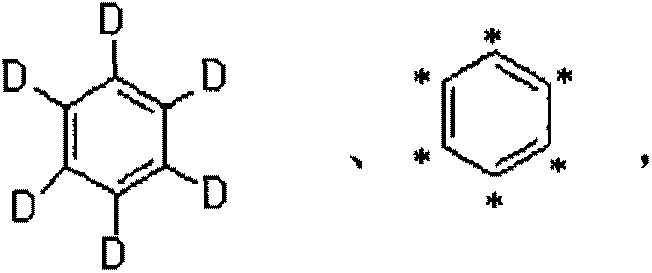Synthetic method for stable isotope labeling basic orange II
A stable isotope and synthesis method technology, applied in the field of stable isotope-labeled basic orange II synthesis, to achieve the effects of simple process, reduced production cost, good economy and use value
- Summary
- Abstract
- Description
- Claims
- Application Information
AI Technical Summary
Problems solved by technology
Method used
Image
Examples
Embodiment 1
[0036] A Stable Isotope Labeled Basic Orange II-D 5 A method for preparing phenyl, the method comprising the following steps;
[0037] 1. Stable isotope labeled nitrobenzene-D 5 preparation of
[0038] Add 8.4g of benzene-D to a 100mL three-necked flask 5 , add dropwise 35g of concentrated nitric acid and concentrated sulfuric acid mixture at room temperature, after the dropwise addition, raise the temperature to 40°C, react for 2 hours, separate and purify to obtain light yellow 10.5g nitrobenzene-D 5 , yield 82.0%, GC detection, purity 98.8%; mass spectrometry detection, abundance 98.7atom%D.
[0039] 2. Stable isotope labeled aniline-D 5 preparation of
[0040] Add 6.4g of nitrobenzene-D5 into a 100mL three-necked flask, add 3mL of concentrated hydrochloric acid, 10mL of water, 13g of iron powder, raise the temperature to 40°C, react for 5 hours, separate and purify to obtain 4.5g of light yellow aniline-D 5 , yield 91.8%, GC detection, purity 99.2%; mass spectrometry...
Embodiment 2
[0045] A stable isotope labeled basic orange II- 13 C 6 A method for preparing phenyl, the method comprising the following steps:
[0046] 1. Stable isotope labeled nitrobenzene- 13 C 6 preparation of
[0047] Add benzene- 13 C 6 4.2g, add 30g of concentrated nitric acid and concentrated sulfuric acid mixture dropwise at 40°C. After the dropwise addition, raise the temperature to 60°C, react for 1 hour, separate and purify to obtain light yellow nitrobenzene- 13 C 6 5.4g, yield 84.4%, GC detection, purity 99.0%; mass spectrometry detection, abundance 99.2atom% 13 c.
[0048] 2. Stable isotope labeled aniline- 13 C 6 preparation of
[0049] Add 6.45g nitrobenzene- 13 C 6, 30mL of tetrahydrofuran, 10g of sodium borohydride was added in batches at 0°C, after the addition was completed, the temperature was raised to 20°C, and the reaction was carried out for 5 hours, separated and purified to obtain 4.6g of light yellow aniline- 13 C 6 , yield 92.9%, GC detection, p...
Embodiment 3
[0055] A kind of synthetic method of stable isotope labeled Basic Orange II, the method comprises the following steps:
[0056] (1) The stable isotope labeled benzene and nitric acid with a molar ratio of 1:1 are reacted under the action of catalyst sulfuric acid to prepare stable isotope labeled nitrobenzene, and the reaction temperature is 0°C;
[0057] (2) Stable isotope labeled nitrobenzene in solvent water and reducing agent H 2 The reaction generates stable isotope-labeled aniline, the molar ratio of the stable isotope-labeled nitrobenzene to the reducing agent is 1:1, and the reaction temperature is 0°C;
[0058] (3) Stable isotope-labeled aniline, diazotization under the acidic conditions of acetic acid, then coupled with m-phenylenediamine, and then acidic transposition reaction to obtain stable isotope-labeled Basic Orange II; described stable isotope-labeled aniline and m-phenylene The molar ratio of diamine is 1:1, and the temperature of the coupling reaction is 0...
PUM
 Login to View More
Login to View More Abstract
Description
Claims
Application Information
 Login to View More
Login to View More - R&D
- Intellectual Property
- Life Sciences
- Materials
- Tech Scout
- Unparalleled Data Quality
- Higher Quality Content
- 60% Fewer Hallucinations
Browse by: Latest US Patents, China's latest patents, Technical Efficacy Thesaurus, Application Domain, Technology Topic, Popular Technical Reports.
© 2025 PatSnap. All rights reserved.Legal|Privacy policy|Modern Slavery Act Transparency Statement|Sitemap|About US| Contact US: help@patsnap.com



